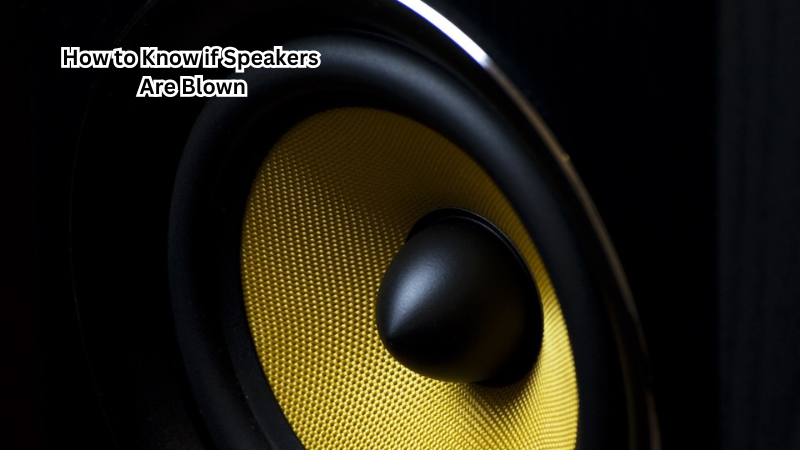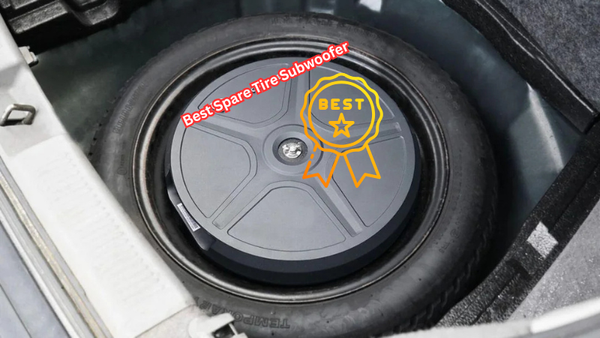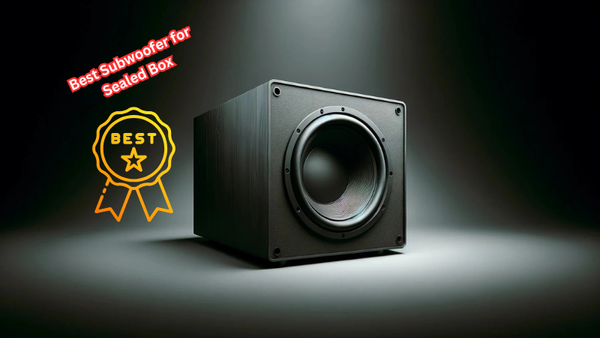Blown speakers can be a frustrating issue, but identifying them is crucial for maintaining audio quality. Recognizing the telltale signs can save you from further damage. A common symptom is a scratching sound, often due to a damaged voice coil or misaligned speaker cone.
If the voice coil wire is compromised, you might hear buzzing noises that distort the sound. Popping sounds can also arise from a malfunctioning audio source or amplifier, indicating potential damage.
Observing these auditory cues allows for a quick diagnosis, helping determine whether the speaker needs repair or replacement. Paying attention to these signs ensures your audio experience remains clear and uninterrupted.
What Do Mean By Speakers Are Blown?
A "blown speaker" refers to a speaker whose internal components have been damaged or compromised in some way. This can happen due to several reasons such as age, overuse, physical damage, and electrical issues. When a speaker is blown, it means that its ability to produce clear and accurate sound has been affected.
If you suspect a speaker is blown, there are a few signs to look out for. The most common one is hearing a popping sound when playing audio at high volumes or through the use of an amplifier (amp). This could indicate that the speaker's voice coil or cone has been damaged and is causing distortion in the sound. Let explore some other ways to tell if your speakers are blown.
Why is Important to Identify Blown Speakers?
Identifying blown speakers is important because it allows you to take action before the issue worsens. If a speaker is damaged and continues to be used, it can cause further problems such as damaging other components in your audio system or even becoming a fire hazard.
Moreover, ignoring blown speakers can result in poor sound quality, ruining your listening experience. By identifying and addressing the issue early on, you can save yourself from costly repairs or replacements down the line.
More importantly, identifying blown speakers can also help you determine if there are any underlying issues with your audio system or equipment. If multiple speakers are blown in a short period of time, it could be a sign of an electrical issue or improper usage.
What Are the Root Causes of Blown Speakers?
There are several root causes for blown speakers, and understanding them can help prevent future damage. Here are some of the most common reasons speakers can become blown:
- Overuse and age: Speakers, like any other piece of equipment, have a limited lifespan. The more they are used, the quicker they will wear out. As speakers age, their internal components can become weakened or damaged, leading to blown speakers.
- Physical damage: Dropping or mishandling speakers can result in internal damage that affects their performance. Additionally, exposure to extreme temperatures or moisture can also cause physical damage to speakers.
- Electrical issues: Problems with your audio system's power or electrical connections can cause speakers to blow out due to excessive voltage or current fluctuations.
- Improper usage: Playing music at excessively high volumes for extended periods of time can put too much strain on the speakers, causing them to blow.
- Defective or low-quality speakers: Sometimes, new speakers can be defective and cause distortion or other issues. Using low-quality speakers can also result in blown speakers due to their inferior construction and components.
Rubbing sound between the voice coil and magnet assembly can also cause damage to speaker components, leading to blown speakers. By the time you hear distortion or other signs of a blown speaker, the damage has already been done. That's why it's important to recognize the early warning signs and take action before it's too late.
How to Know if Speakers Are Blown
Now that we understand what blown speakers are and why it's important to identify them, let's dive into the specifics of how to know if your speakers are blown.
Listen for distortion:
One of the most noticeable signs of a blown speaker is distortion in the sound. This can manifest as a rattling or buzzing noise when playing audio, especially at higher volumes. If your speaker suddenly starts producing distorted sound, it's likely that one or more components have been damaged and need to be replaced.
Pay attention to volume levels:
Another way to tell if your speaker is blown is by paying attention to the volume levels when listening to audio. If you notice that your speakers start to produce distorted sound at lower volumes than usual, this could be a sign of damage. This is because blown speakers tend to struggle with producing clear sound at higher volumes due to their compromised internal components.
Check for physical damage:
Inspect your speakers for any physical damage such as cracks or tears in the cone or damaged voice coil wires. This is especially important if you have recently dropped or mishandled the speaker.
Use a new speaker:
If possible, test out a new speaker to compare sound quality and determine if there is a noticeable difference. A new speaker should produce clear, undistorted sound, while a blown speaker will still exhibit signs of damage.
Lower the volume and listen closely:
In some cases, blown speakers can initially only show signs of damage at lower volumes. To check for this, try playing audio at different volume levels and observe any changes in sound quality.
Look for other signs of damage:
In addition to distorted sound, there may be other signs that a speaker is blown. These can include smoke or burning smells coming from the speaker, visible damage to the speaker's exterior, or no sound at all when playing audio.
A suspect speaker can cause a lot of frustration and inconvenience, especially if it's part of your home audio system. Rattling sound or distortion can ruin your listening experience and diminish the enjoyment of your favorite music or movies. By knowing how to identify blown speakers, you can take the necessary steps to address the issue and prevent further damage.
What to Do if Your Speakers Are Blown?
If you have determined that your speakers are indeed blown, there are a few steps to take to address the issue.
- Stop using the speaker: Continuing to use a blown speaker can cause further damage or even pose a safety hazard.
- Check warranties and return policies: If your speakers are under warranty or within the return period, contact the manufacturer for potential replacements or repairs.
- Replace or repair damaged components: Depending on how severe the damage is, you may be able to replace specific components of the speaker, such as voice coils or cones. You can also bring it to a professional for repairs if necessary.
- Invest in higher quality speakers: To prevent blown speakers in the future, consider investing in higher quality speakers that are built to last and can handle higher volumes without compromising sound quality.
- Take care of your speakers: Properly maintaining and handling your speakers can also help prevent them from becoming damaged or blown. This includes keeping them away from extreme temperatures, moisture, and ensuring proper power and electrical connections.
By following these steps and being aware of the warning signs of blown speakers, you can prolong the lifespan of your audio system and ensure a better listening experience. Re-coning a speaker means replacing its damaged cone and restoring it to its original state, which can be a costly process.
How to Test With an Ohmmeter
To test your speakers with an ohmmeter, follow these steps:
- Disconnect the speaker: First, disconnect the speaker from any power sources and audio equipment.
- Set the ohmmeter to a low value setting: Set your ohmmeter to a low resistance value (e.g., 200 ohms). This will ensure accurate readings for most speakers.
- Touch the meter leads to the speaker terminals: Touch one lead of the meter to one terminal of the speaker, and touch the other lead to the other terminal. Make sure not to touch both leads together or connect them to any other part of the speaker.
- Observe the reading: A healthy speaker should show a low resistance value, usually between 2-8 ohms. If the reading is significantly higher or shows "OL" (open circuit), it could indicate a blown speaker.
- Repeat for each speaker: It's important to test each speaker individually, as one may be blown while others are still functioning properly.
Remember that an ohmmeter only tests the integrity of the electrical connection within the speaker and cannot detect damage to other components such as cones or voice coils. Lower volume levels and listening for distortion are still recommended for a more comprehensive assessment of speaker health.
Is it Worth Fixing a Blown Speaker?
Ultimately, the decision to fix or replace a blown speaker depends on the extent of damage and cost of repairs. For minor issues, such as damaged cones or voice coils, repairing may be a more cost-effective option. However, if the damage is severe or affects multiple components, it may be more practical to invest in a new speaker instead.
Additionally, older speakers that have been used for many years may not be worth fixing as they are likely nearing the end of their lifespan anyway. It's important to weigh the costs and benefits before deciding whether to repair or replace your blown speakers. If in doubt, consult with a professional for their opinion and advice.
FAQs
Is there a way to prevent speakers from becoming blown?
Yes, regular maintenance and proper handling of speakers can help prevent them from becoming damaged or blown. This includes keeping them away from extreme temperatures and moisture, using the correct power and electrical connections, and avoiding overuse.
How much does it typically cost to repair a blown speaker?
The cost of repairs can vary depending on the extent of damage and the specific components that need to be replaced. Simple repairs, such as replacing damaged cones or voice coils, may cost anywhere from $50 to $200. However, if multiple components need to be replaced or the damage is more severe, it could cost up to several hundred dollars.
Can a blown speaker be dangerous?
In rare cases, a blown speaker can pose a safety hazard, especially if it is part of a larger audio system. Excessive amounts of heat and pressure can build up inside the speaker, potentially causing it to explode or catch fire. It's important to stop using a blown speaker and address the issue promptly to avoid any potential hazards.
Conclusion
In conclusion, identifying blown speakers involves being vigilant about specific auditory signs such as scratching, buzzing, and popping sounds.
These noises often indicate issues with components like the voice coil and speaker cone, which may be damaged or misaligned. Addressing these symptoms promptly is crucial to prevent further damage and preserve audio quality.
By taking action—whether through repairs or replacements—you can ensure that your audio experience remains optimal. Paying attention to these signs not only safeguards your equipment but also enhances your enjoyment of clear and crisp sound. Don’t ignore these warning signals; timely intervention will maintain the longevity and performance of your speakers.





